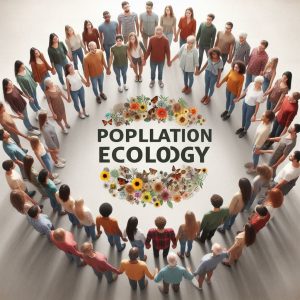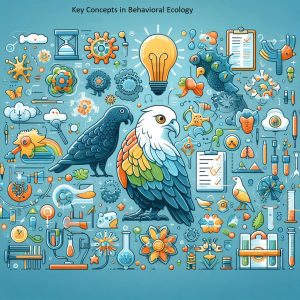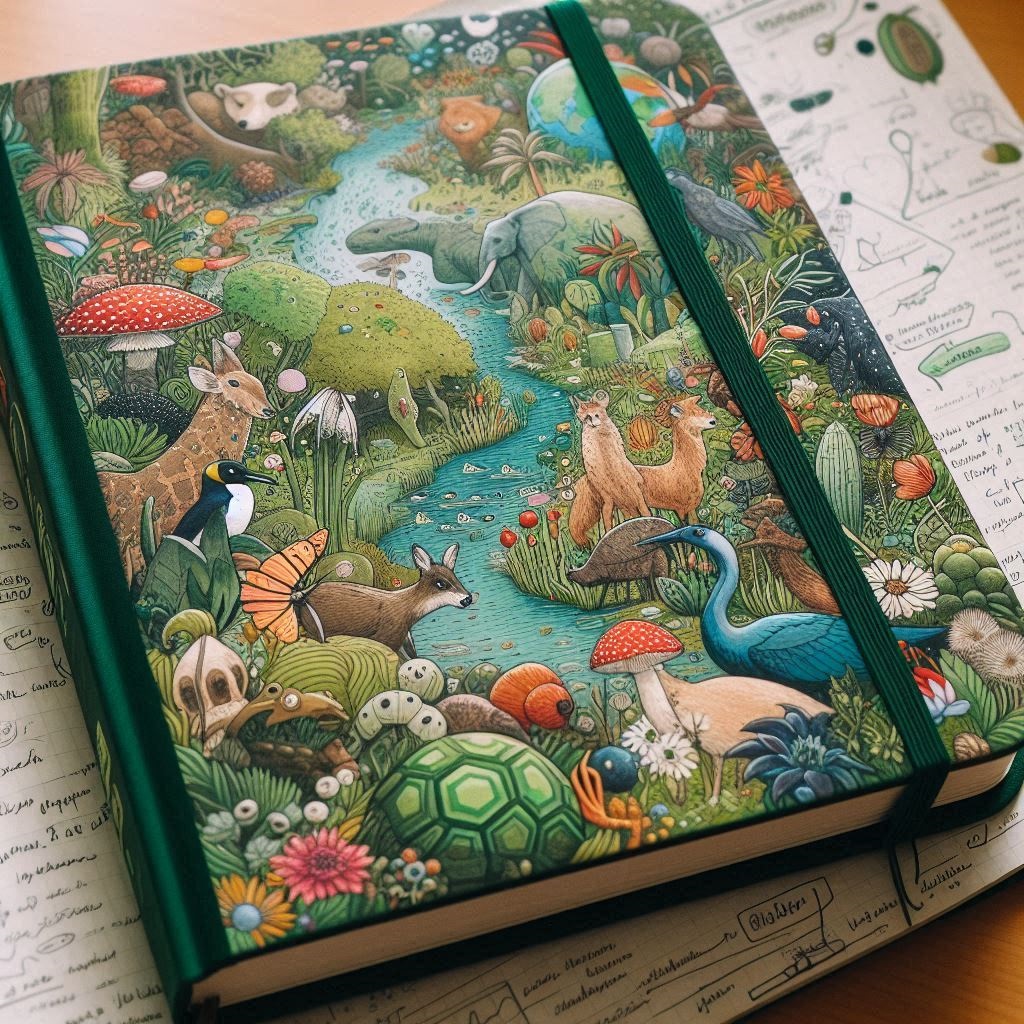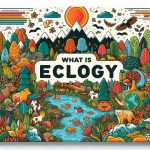Ecology is the scientific study of interactions between organisms and their environment. This field encompasses various levels of biological organization, from individuals to ecosystems, and aims to understand the complex relationships that sustain life on Earth. By examining how organisms interact with each other and their surroundings, ecologists seek to understand the principles governing the distribution and abundance of life, the flow of energy and nutrients, and the functioning of ecosystems.
Key Concepts in Ecology
1. Ecosystems
An ecosystem is a dynamic complex of plant, animal, and microorganism communities interacting with each other and their physical environment. Ecosystems can range from small ponds to vast forests and deserts. They function through processes like nutrient cycling and energy flow. Understanding ecosystems is crucial for managing natural resources and conserving biodiversity. For more on ecosystem dynamics, visit Nature Ecosystems.
Components of Ecosystems
1. Abiotic Factors
Abiotic factors are the non-living components of an ecosystem that influence living organisms. These include temperature, climate, light, soil, and water availability. These factors shape the physical environment and affect the types of organisms that can thrive in a given ecosystem.
2. Biotic Factors
Biotic factors refer to the living components of an ecosystem, including producers (plants and algae that produce energy through photosynthesis), consumers (herbivores, carnivores, omnivores), and decomposers (bacteria and fungi that break down dead organisms). These interactions contribute to the structure and function of ecosystems.
Ecosystem Processes
1. Energy Flow
Energy flow in ecosystems starts with the photosynthesis process in producers, converting solar energy into chemical energy. This energy is then transferred through various trophic levels in the food chain, from primary consumers to higher-order consumers. The energy flow is typically depicted in food webs and energy pyramids, illustrating the decrease in energy at each trophic level.
2. Nutrient Cycling
Nutrient cycling refers to the movement and recycling of essential nutrients, such as nitrogen, carbon, and phosphorus, between the biotic and abiotic components of an ecosystem. These cycles are essential for maintaining ecosystem health and fertility. For more information, visit Nature Nutrient Cycles.
3. Succession and Stability
Ecosystem succession is the process of change in the species structure of an ecological community over time. This process can occur after disturbances, such as fires or floods, leading to the gradual replacement of species and the development of a stable, mature ecosystem. For further reading, refer to Scientific Reports on Succession.
Types of Ecosystems
1. Terrestrial Ecosystems
Terrestrial ecosystems are found on land and include forests, grasslands, deserts, and tundras. Each of these ecosystems has distinct climates, soils, and vegetation types. For a comprehensive overview of terrestrial ecosystems, visit World Wildlife Fund.
2. Aquatic Ecosystems
Aquatic ecosystems include both freshwater (rivers, lakes) and marine environments (oceans, coral reefs). These ecosystems are characterized by their water chemistry, flow, and salinity. For more detailed information on aquatic ecosystems, explore National Geographic Oceans.
3. Estuarine and Coastal Ecosystems
Estuarine ecosystems, where freshwater meets the sea, and coastal ecosystems, including mangroves and salt marshes, are crucial for biodiversity and serve as nurseries for many marine species. These ecosystems are highly productive and vulnerable to environmental changes. For insights into estuarine systems, visit Ecological Applications.

2. Population Ecology
Population ecology focuses on the dynamics of species populations and their interactions with the environment. Key aspects include population size, density, distribution, and growth. Population ecologists use models to study how populations fluctuate over time and space. For insights into population dynamics, check out Springer Ecology Series.
Key Concepts in Population Ecology
1. Population Size and Density
Population size refers to the number of individuals in a population, while density is the number of individuals per unit area or volume. These metrics are crucial for understanding the health of a population and its ability to sustain itself. Factors influencing population size and density include resource availability, predation, and habitat conditions. For more information, check out ScienceDirect Population Density.
2. Population Growth Models
Population growth models help ecologists predict how populations will change over time. The two primary models are the exponential growth model, which describes unrestricted population growth, and the logistic growth model, which accounts for environmental limitations and carrying capacity. These models are used to study species survival and reproductive strategies.
3. Birth and Death RatesRemove featured image
Birth rates and death rates are fundamental parameters in population ecology. The balance between these rates determines whether a population is growing, stable, or declining. High birth rates and low death rates generally lead to population growth, while the opposite results in a decline. For more details on demographic trends, visit WHO Birth and Death Rates.
4. Immigration and Emigration
Immigration (movement into a population) and emigration (movement out of a population) are critical factors that affect population size and dynamics. These movements can influence genetic diversity and population stability. Studying these processes helps in understanding species migration patterns and habitat requirements. For more information, refer to Natural History Museum Migration Studies.
5. Population Regulation
Population regulation involves mechanisms that control population size and prevent uncontrolled growth. These mechanisms include negative feedback mechanisms such as resource limitation and predation. Understanding these factors helps in wildlife management and conservation efforts. For detailed insights, see Springer Population Regulation.
Applications of Population Ecology
1. Wildlife Conservation
Population ecology is vital for wildlife conservation efforts. By monitoring population sizes and trends, conservationists can identify endangered species, assess the impacts of human activities, and implement management strategies to protect wildlife. For case studies and strategies, visit Wildlife Conservation Society.
2. Pest Management
Understanding population dynamics helps in managing agricultural pests and diseases. Ecological models predict pest outbreaks and guide the development of integrated pest management strategies that minimize environmental impact. For resources on pest management, refer to IFAD Pest Management.
3. Ecosystem Restoration
Population ecology aids in ecosystem restoration by providing insights into species requirements and interactions. Successful restoration projects rely on understanding population dynamics to reintroduce species and restore ecological balance. For successful restoration examples, visit Restoration Gazette.
3. Community Ecology
Community ecology studies the interactions between different species living in the same area. These interactions can be competitive, predatory, or symbiotic, and they shape community structure and dynamics. Understanding these relationships is vital for predicting how changes in one species can impact others. Learn more about community interactions from JSTOR Community Ecology.
Key Concepts in Community Ecology
1. Species Diversity
Species diversity is a measure of the variety of different species within a community. It includes both species richness (the number of different species) and species evenness (how evenly individuals are distributed among species). High species diversity often indicates a healthy and resilient ecosystem. For more detailed information, visit Natural History Museum on Species Diversity.
2. Ecological Niche
An ecological niche describes the role and position a species has in its environment, including all its interactions with biotic and abiotic factors. It encompasses a species’ habitat, its interactions with other species, and its role in the flow of energy and nutrients. Understanding niches helps explain how species coexist and avoid competitive exclusion. For further reading, check out ScienceDirect on Ecological Niche.
3. Interactions Among Species
Species interactions play a crucial role in shaping community dynamics. Key types of interactions include:
- Symbiosis: Close, long-term interactions between different species, including mutualism (both benefit), commensalism (one benefits, the other is unaffected), and parasitism (one benefits at the expense of the other).
- Competition: Occurs when species vie for the same resources. This interaction can limit the growth of populations and influence community structure.
- Predation: One species preys on another, influencing population dynamics and community composition.
4. Trophic Levels and Food Webs
Trophic levels represent the position of organisms in a food chain or food web, from primary producers to top predators. Food webs illustrate the complex feeding relationships among species in a community, showing how energy and nutrients flow through the system. Understanding trophic levels and food webs helps in studying energy transfer and ecosystem dynamics. For a comprehensive look, visit Natural History Museum on Food Webs.
5. Community Structure and Dynamics
Community structure refers to the composition and organization of species within a community. Factors influencing community structure include species interactions, environmental conditions, and disturbances. Community dynamics involve changes in community composition over time due to ecological succession, disturbances, and other factors. Understanding these dynamics helps in predicting and managing ecological changes. For detailed studies, explore Springer Community Ecology.
4. Behavioral Ecology
Behavioral ecology examines how animal behavior contributes to survival and reproduction. It explores how behavior is influenced by ecological and evolutionary factors, such as foraging strategies, mating systems, and territoriality. Behavioral adaptations are crucial for understanding species’ responses to environmental changes. For further reading, refer to Behavioral Ecology Journal.

Key Concepts in Behavioral Ecology
1. Adaptive Behavior
Adaptive behavior refers to actions that enhance an individual’s survival and reproductive success. These behaviors are shaped by natural selection and can include foraging strategies, mating rituals, and territorial defense. For more on adaptive behavior, see Nature’s Study on Adaptive Behavior.
2. Foraging Behavior
Foraging behavior involves how animals search for and obtain food. This includes decisions about where to forage, what to eat, and how to balance the energy gained from food with the risks of obtaining it. Models such as Optimal Foraging Theory help explain these behaviors.
3. Mating Systems and Reproductive Strategies
Behavioral ecologists study various mating systems, such as monogamy, polygamy, and promiscuity, and how these systems influence reproductive success. Factors influencing mating behavior include mate choice, competition, and parental care. For detailed research on mating systems, visit JSTOR’s Research on Mating Systems.
4. Territoriality and Social Behavior
Territoriality involves defending a specific area against others of the same species, which can affect access to resources and mating opportunities. Social behavior encompasses interactions within groups, such as cooperation, competition, and hierarchy. Understanding these behaviors is crucial for insights into social structure and dynamics. For more information, check Cambridge Behavioral Ecology.
Applications of Behavioral Ecology
1. Wildlife Management and Conservation
Behavioral ecology provides essential insights for wildlife management and conservation. Understanding animal behavior helps in designing effective conservation strategies, managing endangered species, and mitigating human-wildlife conflicts. For case studies, visit IUCN Wildlife Management.
2. Agricultural Pest Management
Behavioral ecology can inform strategies for managing agricultural pests. By understanding the behavior of pests, scientists can develop targeted control measures that minimize environmental impact. For resources on integrated pest management, see APS Integrated Pest Management.
3. Understanding Human-Animal Interactions
Behavioral ecology also helps in understanding interactions between humans and animals, such as domestication, wildlife tourism, and urban wildlife management. Insights gained can enhance human-animal coexistence and promote sustainable practices. For further reading, visit The Wildlife Society on Human-Animal Interactions.
5. Conservation Ecology
Conservation ecology is concerned with the preservation and restoration of biodiversity. It involves studying the impacts of human activities on ecosystems and developing strategies to mitigate these effects. Topics include habitat loss, climate change, and species extinction. For more information on conservation efforts, visit Conservation International.
Applications of Ecology
1. Environmental Management
Ecology plays a crucial role in environmental management by providing knowledge needed to manage natural resources sustainably. This includes assessing environmental impacts, developing conservation plans, and restoring degraded ecosystems. For insights into environmental management practices, see EPA Environmental Management.
2. Agriculture and Land Use
Ecological principles are applied in agriculture to optimize crop production and minimize environmental impact. Techniques such as sustainable farming, agroecology, and integrated pest management rely on ecological knowledge. Learn more about these practices from ScienceDirect Agroecology.
3. Urban Planning
Ecology informs urban planning by incorporating green spaces, promoting biodiversity, and managing urban heat islands. Understanding the ecological impacts of urbanization helps in creating sustainable and resilient cities. For more information, explore Urban Ecology.
Conclusion
Ecology provides a comprehensive framework for understanding the complex interactions within and between ecosystems. By studying these relationships, ecologists can address pressing environmental challenges, inform conservation efforts, and guide sustainable practices. As our understanding of ecological principles continues to evolve, the insights gained will be crucial for ensuring the health and stability of our planet’s ecosystems.
FAQs on Ecology
1. What is ecology?
Ecology is the scientific study of interactions between organisms and their environment. It encompasses various levels of biological organization, including individuals, populations, communities, ecosystems, and the biosphere. For a detailed introduction to ecology, visit Britannica’s Ecology Overview.
2. Why is ecology important?
Ecology is crucial because it helps us understand how ecosystems function, how species interact, and how environmental changes impact biodiversity and ecosystem services. This knowledge is essential for conservation efforts, resource management, and addressing environmental challenges. Learn more at National Geographic on Ecology.
3. What are the main branches of ecology?
The main branches of ecology include landscape ecology, behavioral ecology, population ecology, functional ecology, and community ecology. Each branch focuses on different aspects of ecological interactions and processes.
4. What is an ecosystem?
An ecosystem is a community of living organisms interacting with each other and their physical environment, functioning as a unit.
5. What is biodiversity?
Biodiversity refers to the variety of life in a particular habitat or ecosystem, including the diversity of species, genes, and ecosystems.
6. How do ecologists conduct research?
Ecologists use various methods, including field observations, experiments, and computer models, to study ecological relationships and processes.
7. What is the difference between a habitat and a niche?
A habitat is the physical environment where an organism lives, while a niche is the role an organism plays within its habitat, including its interactions with other species.
8. What is conservation ecology?
Conservation ecology focuses on protecting and restoring biodiversity, often through habitat preservation, species recovery programs, and sustainable management practices.
9. How does climate change affect ecology?
Climate change affects ecology by altering habitats, shifting species distributions, and impacting the timing of biological events such as migration and reproduction.
10. What are invasive species?
Invasive species are non-native organisms that spread rapidly in a new environment, often causing harm to native species and ecosystems.
11. What is ecological succession?
Ecological succession is the process of change in the species structure of an ecological community over time, often following a disturbance.
12. What can individuals do to help protect the environment?
Individuals can help protect the environment by reducing waste, conserving water and energy, supporting conservation efforts, and promoting sustainable practices.
Disclaimers
The information provided in this article is intended for educational purposes only and should not be considered as professional ecological advice. While we strive to ensure the accuracy and reliability of the information, ecological science is continually evolving, and new research may lead to changes in understanding and best practices. For specific ecological concerns or advice, consult a certified ecologist or environmental scientist.
Cautions
1. Environmental Variability: Ecosystems are complex and dynamic. Predictions and models may not always accurately represent real-world conditions due to the inherent variability in natural systems.
2. Interconnectedness: Actions taken to address ecological issues can have unintended consequences due to the interconnected nature of ecosystems. It is important to consider the broader impacts of any ecological interventions.
3. Human Impact: Human activities can significantly impact ecosystems. Mitigation strategies should be carefully designed to balance environmental protection with human needs and development.


